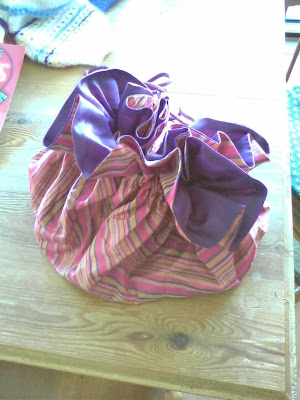
I'm doing something that I never, ever do. You all know by now that I've been working like a dutiful knitter on Christmas presents since June. And I'm going along pretty well, I'm proud of how far ahead of the game I am and how much I've gotten finished so far, with months yet to go before the holidays.
Until I got to my eldest sister's socks. She is a browns and rusts and oranges person, and so these socks are knitted from stash yarn in a pattern called Oak Leaf. This is a fairly easy, textured stitch pattern combining cables and lace, and it is looking gorgeous in her colors. I know she'll love these socks. But it is not in the least intuitive. Typically, lace and cable patterns become instinctive after a repeat or two. You just know in each row where the cables or the K2tog, SSKs and yo's go next. Until this one. So, in a nod to my hormones and in a bid for sanity, after finishing the first sock I have put the project into 'time out', and cast on something for myself.
The February Lady sweater. This cardigan pattern, available free through Ravelry, is based on a baby sweater pattern by Elizabeth Zimmerman. Pamela Wynne up-sized it for women, and this particular cardigan is the hottest thing since sliced bread right now. And I just happened to have enough worsted weight Cascade 220 Heather in my stash from a going-out-of-business sale a couple of years ago. I don't think the photos show the color off properly, but it is a heathered mixture of pine green and navy blue, with an odd red haze over it that is truly gorgeous.

When one even begins a sweater there are a few things to think about, and decisions to make. It is important that you consider all the various stages and their options so that you can plan the finished result before casting on the first stitch.
First, Cast-on and Bind-off. Are they going to show? In this case - a top-down raglan - the answer is yes. The cast-on is the neckline, and the bind-off is the bottom hem and the sleeve edges. This sweater begins and ends with garter stitch, so I opted to use a Latvian Cast-on (not to be confused with the Latvian Braid Cast-on), as I like the way it imitates garter stitch. I'll end with the Latvian Bind-off and have the same effect at hem and sleeve edges.

Next, I need to think about my opening edges of the cardigan. Are they going to show just as they are knitted, or will a button-band be added later? In this case, the selvedge edges will be used as is, and the button band is knitted as you go. I opted to slip my edge stitches in my favorite way - K1tbl in the first stitch in every row, work to the last stitch, yarn forward as if to purl, slip the last stitch as if to purl.
Now, there are raglan increase lines - how do I want to treat them? I have several options: I can work them according to the pattern by working them as - M1,K1,M1. This leaves a less defined and more subtle raglan line. I could work them with eyelets - yo,K1,yo. Or I can make them with a defined line by following the M1,K1,M1, but purling that center stitch on the wrong side rows. This makes the raglan lines stand out against the garter stitch background - as in mitred corners. I went with the last choice.

With a top-down raglan, after you knit the yoke of the sweater with the raglan increases, you separate the sleeves stitches from the rest of the body stitches, and put the sleeve stitches onto waste yarn. Next, you will typically cast on a small number of stitches at the underarm area that become part of the lower body stitches. Later, after the body is finished and it is time to pick the sleeve stitches up from the waste yarn and begin to knit the sleeves, you will pick up stitches at the top of those cast-on stitches at the underarm. These become part of the sleeve stitches. Because the body and the sleeves below the division point in this cardigan are knitted in a lace pattern, there isn't a secure edge to pick up sleeve stitches from later. Considering this, I cast on the underarm stitches using a Crochet Cast-on with waste yarn, then slipped these waste yarn stitches back to the right needle and knitted across them with my working yarn. Later, when it is time to work the sleeves, I can pick out the waste yarn and have live stitches to work from.

Because I have thought through the various stages of the project before beginning, I am better prepared for what happens next, have more control over the finished product, and am happier with the more finished results. Planning ahead also give you time to practice any new techniques on a swatch before incorporating them into your project.






